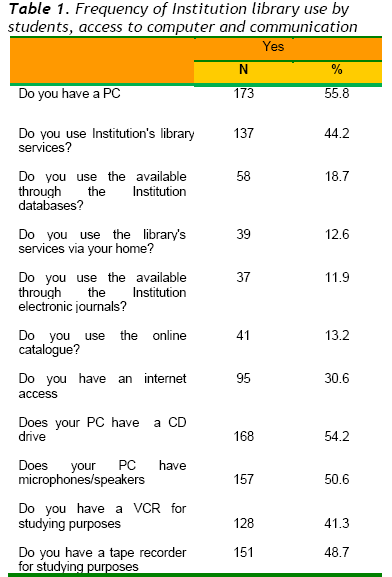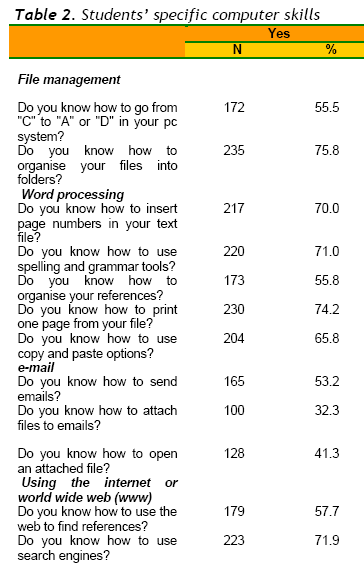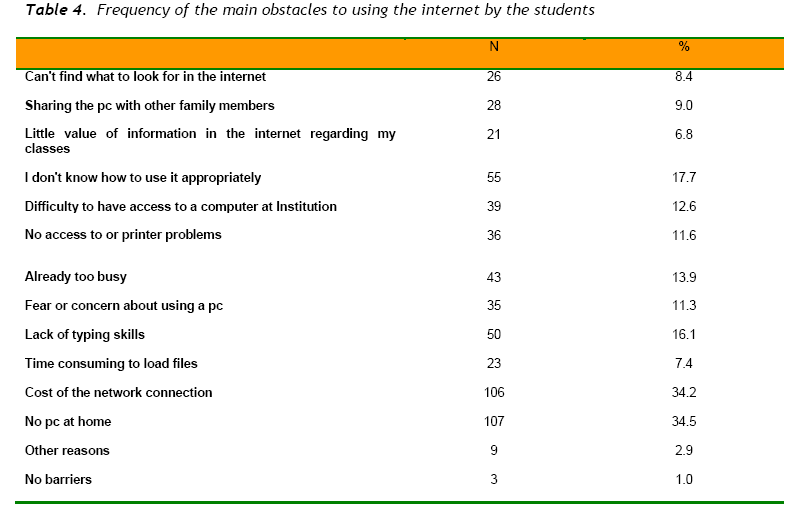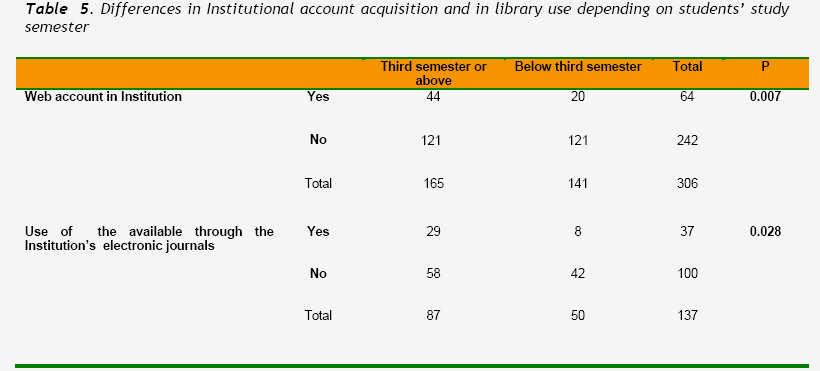Keywords
Flexible learning, information technology, computer skills, nurses students
Introduction
We live in the era of information technology (IT). Many health care organizations have adopted policies favoring the implementation of modern technology. Computers are used not only for diagnosis and imaging techniques but also in home care and long –term facilitie [1,2]. As a consequence, health care organizations are becoming more information intensive. On the other hand, the introduction of technology and the internet into classrooms has been the most important change in the field of education in the past 100 years. Both students and educators need time to reflect on this changing content and make the maximum advantage of IT [3]. It is important that nurses are able to demonstrate competence in the use of IT. It is necessary to acquire the basic skills in information technology that will allow them to progress through their educational program. The computers are expected to play a significant role in nursing studies. Both educators and students have to be aware of technology evolution and must be equipped with skills to provide learning opportunities via computer to advance students’ knowledge. The interest in the so-called flexible learning is increasing nowadays and students choice these modes of studies and bear responsibilities in the learning process [4,5]. Even though flexible learning is not depended on technology, the use of information technologies allow a better access to learning material, as well as to other students and teachers at different times and locations. Without IT competencies and confidence in their own computer skills, learning and research opportunities are very limited. The aim of this study was to investigate nursing student’s self reported attitudes skills in IT use for study purposes.
Methodology
This was a cross-sectional study using a survey design. The study was carried out at a school of nursing in Central Greece. Following a review of the relevant literature, we chose an assessment tool of computer competences in students developed by Honey [4]. The survey instrument was used to determine access to computers and communication technology, computer proficiency (self rated using a [5] point Likerttype scale), computer skills, use of the Institutional library and obstacles to using the Internet. This closed-question questionnaire was translated into Greek and back translated by another bilingual expert in order to ensure the accuracy of translation, after which it was tested on a group of 20 third-year student nurses near the end of their training and no problems were recognized with face validity. This instrument was distributed in student nurses and completion and return of a questionnaire was interpreted as voluntary consent to participate. The questions were easy to understand and it took 8 min to complete.
The test for internal consistency (Cronbach’s Alpha) rendered a score of 0.80, demonstrating a satisfactory reliability coefficient, [6] and the instrument was thus considered to be appropriate.
For the collection of demographic data, a different questionnaire was developed, including participants’ age, semester, status of employment and nationality, as well as the educational level of their parents.
Data Collection: Ethical approval was granted by the Institution’s Ethical Committee. The researchers had the opportunity to meet with students during their first week in the classroom.
The students were given a brief written research proposal and asked to answer all questions. They were told that their responses would be kept confidential and that if they did not wish to participate they should feel free to submit a blank questionnaire. In addition, they were promised that as soon as their data had been entered into the computer along with a code number identifier, their questionnaires would be disposed of.
Students of first, fourth and fifth semester were finally enrolled in the study. The questionnaire was administered to 325 students. Three hundred and ten questionnaires were finally returned (95.3% response rate).
Statistics
Statistics was processed by SPSS, 8.0 v. Descriptive statistics were at first conducted, while χ2 and Mann –Whitney –UTest were executed in order to compare nominal and ordinal data respectively. Percentiles were used to present nominal data. Statistical significance was set at 0.05 level.
Results
A total of 325 students enrolled in the semester, and 310 completed the survey, giving a response rate of 95.3%. Among them 67.7 % (210 students) were female and 32.3 % (100 students) were male. The large majority of students (90 %) were below 25 years of age. More specific, 45.8 % (142 students) were below 20 years old, 44.2% (137 students) were between 20 and 25, 26 to 30 were 3.9% (12 students), 3.2% (10 students) were between 31 and 35, 2.6% (8 students) were between 36-40 and one student was over 40 years old and 27.7% (86 students) were employed. Half of them had a PC of their own, but internet access was limited to 30 % (Table 1).

Over 55% were in general familiar with word processing. However, about two thirds of them were not skillful in internet usage. The majority of the students knew how to use search engines (Table 2). Owing a PC had a great influence on their computer knowledge assessment (Table 3), which in general was at low levels. 12.6% (39 students) reported a very good knowledge on PC use, and no knowledge at all 4.6 % (14 students). Good, efficient and beginner’s knowledge was reported by 30.0% (93 students), 27.4% (85 students) and 24.8 % (77 students) respectively, while 0.6 % (2 students) gave no answer. Usage of library electronic data bases was poor, limited to about 12 % of the students, while the main obstacles to using the internet was the high cost of internet connection and the absence of PC at home (over 30 %) (Tables 1 & 4). More senior students had an Institution’s web account and used the available through the Institution’s electronic journals (a statistically significant difference, p<0.05, see Table 5). Percentages in tables 1-5 are not to be added, as students could give more than one answer. Some students did not complete all the sub-questions.




Discussion
New information relevant to nursing practice doubles every 5 years, indicating a rapid surge in nursing research. Nevertheless the percentage of nursing staff that use data generated by research is rather small, [7] and, even in developed countries, there is a slow emergence of nursing informatics in nursing curricula [8].
During the past two decades the computer training has been integrated into the curriculum of many upper secondary schools in Greece [9]. However, the findings of this study suggest that IT competencies of nursing students are far behind of flexible learning requirements. Computer is at best seen as an advanced model of typewriter. Students seemed more skilful in wordprocessing than in communicating with others via e-mail, especially when messages have to be attached. While over 50 % knew how to send mails, only one out of three students knew how to attach files to mails. Despite the fact that these percentages are far behind those found in other technologically advanced countries, this difference is a common finding, indicating that familiarity itself is not adequate [4,10,11]. Flexible learning demands more skillfulness [4]. Moreover, it was found that only half of them reported that they knew how to search the literature. Lack of specific knowledge is prominent, as a disparity is revealed between 70 % who answered they know to use search engines and 57 % who report they know how to find references in the web. It is not surprising that library usage was at low levels. Even though 44 % reported they use the Institution’s library services, less than 15 % use the on line catalogue or the electronic journals. Overall the Institution’s library services were underutilized by nursing students, since 55% of the students did not use the library. Students hardly assess their computer knowledge as intermediary. This finding is reported in other studies as well. According to the study of Griffiths & Ridington, nurses showed limited confidence and low frequency in using the databases [12]. In another study in Portugal it was found that nurses’ knowledge on information technology was basic and intermediary and acquired mostly by self teaching.
It is possible that the above findings reflect the current status in IT penetration in education in Greece, which is still in infancy, in comparison with the most Western European countries [13]. It is remarkable that approximately 55.6 % of students reported that they have not a PC at home, while a 34. 5 % regarded this fact as an obstacle to using internet. Indeed, experience with using computers has been found to influence the person’s perception of their skill with computers [14]. Access to internet resources at worksites as well as in institutions, along with training and time for searching is necessary for the development of skills enabling effective use of information technology [15]. When students were divided into two groups, those who have a PC at home and those who have not, the same difference occurred in the present study as well.
A study in Sweden found that nursing students who used computers at home rated themselves as more skilled in using computers [4]. In any case the low penetration of internet in Greece is a discouraging factor. The internet usage in Greece is at rather disappointing levels [13]. More specific, and according estimations for the year 2007, the penetration in population was 35 %, while in Western and Northern Europe reached 90 % in some cases with the mean value being over 50 %. This fact could be at least attributable to the high cost of internet connection in Greece, compared with other European countries. It is at least twice as much compared with the average cost in the USA and 30 % in the rest of Europe [13,16]. The greatest price reduction took place in 2007, so the results are yet to be seen. It is noticeable that nursing students in other surveys rated reasons other than cost as the most important obstacles in internet usage (approximately 11% ), while inability to find the requested material came first. This was just the opposite picture of the present study and reflects partly the obstacles in communication facilities that countries in southern Europe face. In Sweden, 66 % of nursing students had access to internet at home, [2] while in New Zealand this percentage reached to 93 % [4].
When structured learning activities are integrated into nursing courses, students report an enhanced level of comfort in computer technology by completion of the course as compared with the onset [17]. Dørup studied the availability, usage and attitudes of first semester medical students in Denmark. In the final semester 90% of the students used e-mail regularly and 60 % had access to the internet from home. The study took place between 1998 and 2002, when there was a rapid increase in internet penetration in Denmark [18].
This survey has highlighted that most nursing students have not convenient access to computers and information technology for study purposes. The findings of this study combined with previous research indicate the necessity for nursing students to have basic skills in IT. This includes familiarity with e-mails, word processing and accessibility to a variety of databases. The introduction of computers into the health care system has crested anxiety fear and resistance among nurses [19]. Computers are often imposed without adequate preparation and support for the nurses involved. A systematic effort has to be taken in order new technology to be incorporated in nursing studies [20]. Web-based learning can be an effective mode of delivery for nursing education [21]. This would lead to the successful implementation of new learning options, including flexible learning.
Conclusions
The survey of undergraduate nursing students at the Nursing Department of Technological Educational Institute of Lamia has highlighted that not all students have convenient access to computers and information technology for study purposes. Therefore, there are direct implications for nurse educators and curriculum developers. Curriculum working group members are supposed to think about creating a basic level technology skills test to assess students’ level of technology competency at their admission to the nursing school. In addition, educators have to know if today’s nursing students are competent of transferring their current technology skills to nursing/hospital information systems in clinical settings or computer technologies used in institution. The introductory course to nursing/healthcare informatics which is already included in curricula of the nursing studies in Greece does not considered to be adequate for the students regarding their competence in technology skills. Thus, introducing a set of technology courses throughout the nursing program of study, with the goal of enhanced preparing students for this era of rapidly altering technological advancements, is vital. This educational imperative will assist future nurses to exhibit informatics competencies at the point-of care and assist interested future nurse educators to use appropriate ubiquitous elearning tools in classroom settings.
3604
References
- Ragneskog H, Gerdner L. Competence in nursing informatics among nursing students and staff at a nursing institute in Sweden. Health Info Libr J. 2006;23(2):126-32.
- Alexander B. Going Nomadic: Mobile Learning in Higher Education. EDUCAUSE Review. 2004; 39 (5): 28?35.
- Honey M. Flexible learning for postgraduate nurses: a basis for planning. NurseEduc Today. 2004;24(4):319-325.
- Clifford P, Goldschmidt K, O'Connor T. Staff nurses writing for their peers: development of self-learning modules. J Nurs Staff Dev. 2007;23(6): 283-8.
- LoBiondo ?Wood G, Haber J. Nursing Research: Method, Critical Appraisal for Evidence-Based Practice.6th Ed. St. Louis: Mosby-Year Book, Missouri, 2005.
- Carlock D, Anderson J. Teaching and assessing the database searching skills of student nurses. Nurse Educ. 2007;32 (6): 251-5.
- Hardy JL, Lindqvist R, Kristofferzon ML, Dahlberg O. The current status of nursing informatics in undergraduate nursing programs: comparative case studies between Sweden and Australia. Stud Health Technol Inform.1997;46:132-6.
- Plomp T, Anderson RE, Kontogiannopoulou- Polydorides G. Cross National Policies and Practices on Computers in Education, volume 1, Springer Netherlands, 1996, p.p:223-247.
- Janes R, Arroll B, Buetow S, Coster G, McCormick R, Hague I. Rural New Zealand health professionals' perceived barriers to greater use of the internet for learning. Rural Remote Health. 2005;5(4): 436.
- Severo CL, Cogo AL. Access and knowledge of nursing undergraduates on computational resources. Rev GauchaEnferm. 2006;27(4):516-23.
- Griffiths P, Riddington L. Nurses? use of computer databases to identify evidence for practice ?a cross-sectional questionnaire survey in a UK hospital. Health Info Libr J. 2001; 18 (1): 2?9.
- Internet World Stats Internet [homepage on the Internet]. Usage in Europe Internet User Statistics & Population for 52 European countries and regions. Available from: https://www.internetworldstats.com/stat s4.htm.Accessed :16-4-2008
- AMA: helping doctors help patients Chicago: American Medical Association;1995-2007 Available from: https://www.ama-assn.org/. Accessed:22- 2007
- Austin SI. Baccalaureate nursing faculty performance of nursing computer literacy skills and curriculum integration of these skills through teaching practice. J Nurs Educ. 1999;38(6):260-6.
- Gilmour JA, Scott SD. Huntington N. Nurses and Internet health information: a questionnaire survey. J AdvNurs. 2008; 61(1):19-28.
- Xanthidis D, David N. Evaluating internet usage and e-commerce growth in Greece. Aslib Proc. 2004;56 (6):356-366.
- Draude BJ, McKinney SH. Senior Nursing Students Comfort levels with computer [Internet]. Eric Education Resources Information Center; 1998 [updated 2007 May 12; cited 2008 April 16]. Available from: https://www.eric.ed.gov/ERICWebPortal/ custom/portlets/recordDetails/detailmini .jsp?_nfpb=true&_&ERICExtSearch_Search Value_0=ED431392&ERICExtSearch_Searc hType_0=no&accno=ED431392.
- D?rup J. Experience and attitudes towards information technology among first-year medical students in Denmark: longitudinal questionnaire survey. J Med Internet Res. 2005; 6 (1): e10.
- Jacso P. Google scholar: The pros and cons. Online Information Review. 2005;29(2): 208-214.
- Nelson R, Meyers L, Rizzolo MA, Rutar P, Proto MB, Newbold S. The evolution of educational information systems and nurse faculty roles. NursEducPerspect. 2006;27 (5): 247-53.
- Atack L, Rankin J. A descriptive study of registered nurses' experiences with webbased learning. J AdvNurs. 2002;40(4):457-65.










